
A single day is definitely not long enough to fully appreciate how busy the Vineland Research and Innovation Centre has become.
A single day is definitely not long enough to fully appreciate how busy the Vineland Research and Innovation Centre has become.
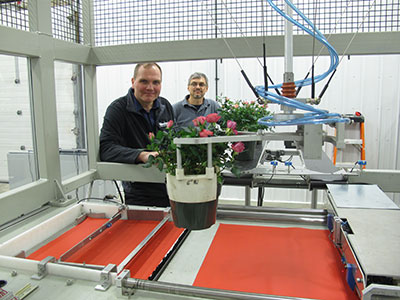 |
|
| John Van De Vegte, with Cristian Pop from AEMK Systems. TOP PHOTO COURTESY VINELAND RESEARCH AND INNOVATION CENTRE Advertisement
|
And it will only get busier, now that construction has begun on a new state-of-the-art greenhouse complex.
Late last spring, I spent a day with a few of the researchers to a snapshot view of some of the greenhouse-related studies – Vineland also has programs for other branches of horticulture – that are being done that, within a very short time, will be benefitting the industry.
Growers have taken note.
“We have been involved in several projects with Vineland including breeding, marketing, and automation,” explains Rodney Bierhuizen of Sunrise Greenhouses.
“It has been seamless collaboration with every project.
“We were able to provide researchers with industry experience which was used to focus their research and develop industry solutions. Depending on a particular grower’s challenges, new varieties, biological controls, energy management are a few of the many areas growers are interested in having research done,” says Bierhuizen.
“The research team at Vineland encompasses a broad range of disciplines to address the issues facing our industry today.”
Vineland has quickly and firmly established itself a leading North American horticulture research centre. And that’s especially impressive given that it has only been operating since 2007.
What has been lacking, however, are world-class greenhouse facilities to match those of the commercial sector it serves.
Until now.
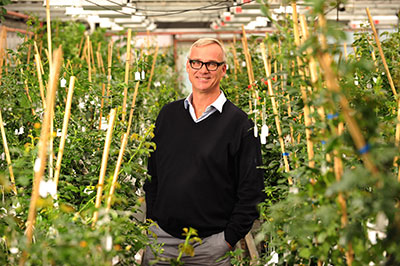 |
|
| Dr. Jim Brandle.. PHOTO COURTESY VINELAND RESEARCH AND INNOVATION CENTRE |
Construction is well underway on a 3,700-square-metre, state-of-the-art greenhouse complex. It’s definitely an elite project, as there are only a few pre-commercial scale research greenhouses in North America.
There will be two vegetable units of 540 square metres each, with a gutter height of seven metres.
There will also be 11 ornamental units of varying sizes totaling 1,080 square metres. The gutter height is five metres.
The new facilities are long overdue. Vineland’s oldest greenhouse dates back to 1967, while the newest was opened in 1983.
“We need to be on the same level as commercial growers to be part of the game,” says CEO Dr. Jim Brandle. “We want to be able to operate like a commercial operator and do our research in that kind of facility so that it is immediately relevant to the industry.”
GROWER INPUT
Growers had a lot of input into the project. Representatives from the Ontario Greenhouse Vegetable Growers and Flowers Canada Growers participated in planning workshops with Vineland staff.
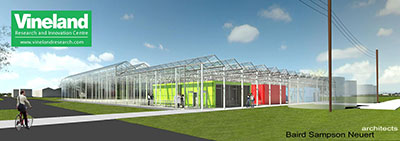 |
|
| Artist’s rendering of the new greenhouse.
|
Featured will be insulated glass sidewalls and below-ground trenching to reduce shading. Temperature and humidity levels will be completely controllable in all growing areas.
It will be operational by the spring.
“Vineland is all about results,” says Brandle. “Our projects have research components and innovation components, and we like to see them all the way to the end, to see it in a grower’s hands or see it in a store where the consumer has a better experience with it.”
Brandle was Vineland’s first employee, arriving on the scene in June 2007. There are now 86 core staff on hand, augmented by contractors throughout the year and students in the summer.
In August 2006, then Ontario agriculture minister Leona Dombrowsky appointed a committee – the Vineland Renaissance Panel – to examine the revitalization of the centre, which was celebrating its centennial.
Following extensive consultations, the panel submitted a 10-year business plan with a vision of Vineland becoming “a world-class research institution and international hub for horticulture and floriculture research, innovation and commercial activity…”
Vineland is not only innovative, it’s partnership-driven.
It combines research and innovation with strong government and industry partnerships to create solutions that can be immediately transferred to the marketplace.
Every project must have three components, Brandle explains.
- It must have a validated consumer concept.
“It means that someone really wants it and that it is really going to make a difference.” The economic potential of the idea must be clearly evident.
- It must have good science and good scientific partnerships.
- It must have good industry partners.
“At the end of the day, we’re not a seed company or a nursery or a grocery store. We need those partners to deliver the product to the marketplace.”
GREATER SUCCESS
When all three components are in place, and you’ve done a good job, “your probability of success goes way up.”
Key to Vineland’s success is its strong Consumer Insights program, which is involved in almost all the projects. “We need to understand what people like and be able to translate that into what people want.”
Vineland also has strong business expertise to help take projects to the market. “We have to commercialize those innovations we’ve developed.”
The Vineland model has attracted considerable attention from throughout North America and overseas. “People are quite interested in our model and how it works, and where the success is coming from.”
In 2013, for example, Vineland welcomed around 1,500 visitors, many of them horticulture and floriculture growers from North America, Europe and Australia.
It is clear that the federal and provincial governments believe in the Vineland model. This past spring, Vineland received $26.5 million in Growing Forward 2 funding.
“We are delighted with the continued confidence shown in Vineland,” said John F.T. Scott, Vineland’s board chair. “Through collaboration with a wide-range of industry partners, Vineland is working every day to increase competitiveness for the Canadian horticulture industry with ground-breaking research and innovation.”
Canadian Hardy Rose PROGRAM expands
Vineland is home to a one-of-a-kind rose breeding program with a truly global market potential.
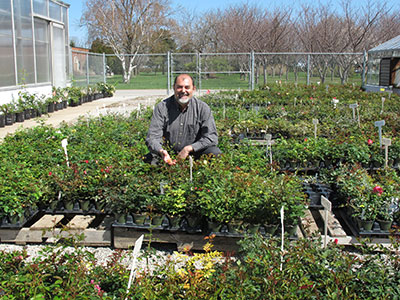 |
|
| Dr. Rumen Conev takes a closer look at some varieties in the trials
|
“There is no other program in the world that’s focused on cold hardiness that’s comparable to ours,” says Dr. Rumen Conev, who heads up Vineland’s rose breeding program. “In this sense, we’re unique.”
And when Conev talks about cold hardiness, he’s looking for varieties with definite resilience. They will be able to withstand temperatures of -35 C to -40 C without mulching or similar protection.
But, just as importantly, these new Canadian Hardy Rose varieties are also being bred for resistance to black spot disease. “Breeding for disease resistance opens new markets. We’re not restricted to colder regions, we can compete in warmer regions, too.”
Such cold hardiness coupled with black spot resistance will find broad customer appeal in markets throughout the world.
“At the moment,” says Conev, “there is no commercially available germplasm on the global markets combining these two traits.”
TRAITS TARGETED
And that’s not all. The breeding will also target:
- Tolerance to powdery mildew.
- Attractive flowers, both in colour and in a large number of petals.
- “Self-cleaning,” as the spent flowers will not brown and stay on the plants.
- Repetitive or continuous blooming.
- Dark green, attractive, glossy, healthy foliage.
- Fragrance.
By way of background, in 2010, the Canadian Nursery Landscape Association (CNLA) obtained the rights to Agriculture and Agri-Food Canada’s Hardy Rose Breeding Program, including all of its germplasm.
ROOTS IN THE 1950s
The AgCanada program, with roots in the 1950s, had sites in Ottawa, Saint-Jean-sur-Richelieu (Quebec), and Morden (Manitoba). It released many consumer favourites in the “Canadian Explorers,” “Parkland,” and “Canadian Artists” series.
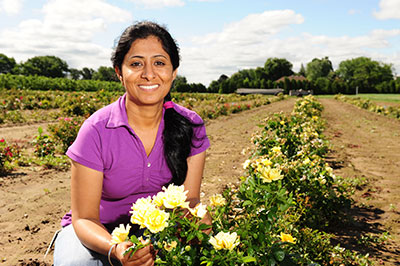 |
|
| Dr. Parminderjit Sandhu, a Senior Research Technician, Plant Breeding. Photos courtesy Vineland Research and Innovation Centre.
|
In a collaborative effort, Vineland Research and Innovation Centre (Vineland) assumed the breeding responsibility for the research program.
The breeding is closely supported by Vineland’s pathology, bioinformatics and molecular biology teams, as well as with consumer preference research, and in-house business development and marketing.
“We breed for classic garden roses as well as for landscape roses suitable for mass planting, ground cover as well as container and patio grown plantings.”
And what are consumers looking for? “First of all, it has to survive. It has to be beautiful, and it has to be beautiful for as long as possible to match the expectations of consumers. During the period when it isn’t in bloom, it still has to be beautiful with glossy, green foliage. And it has to be fragrant.”
Working on that long shopping list of desirable rose variety traits is reflected in the extensive breeding program Conev has established over the past four years.
COAST-TO-COAST TRIALS
“We’re launching a Pan-Canadian testing network with collaborating nurseries and academic institutions from coast to coast,” he explains.
The team is busy performing over 15,000 crosses each year and combining the heredity of 100 parental varieties and lines from Canada and around the globe. Every year, 10,000 to 15,000 hybrids are planted at Vineland and evaluated for ornamental display and resistance to black spot disease.
The best of these roses are sent to collaborators across Canada, including the University of Saskatchewan, for further testing in a variety of climatic conditions for black spot resistance and winter hardiness.
Following two to three years of rigorous testing in harsh conditions without fungicide sprays and winter protection, a couple of the best performing and adapted varieties will be selected for commercialization each year.
The first introductions are expected to be on the market by the spring of 2018. The hope is for two to three releases each year after that. The royalties will be streamlined back to research, thus gradually supporting the self-sustainability of the program.
In addition to the traditional Canadian market, Vineland’s Business Development team is working to establish partnerships in the U.S. and Europe.
UNTAPPED MARKETS
Russia, Eastern Europe and Scandinavia are rapidly growing but mostly untapped markets where Canadian roses have a solid reputation.
The breeding targets are verified by extensive consumer feedback. “We want to be sure of what consumers want before we release anything.”
The rose is definitely on the rise at Vineland, with a steady flow of hardy and appealing varieties soon making their way to an appreciative market.
DEVELOPING BETTER VARIETIES VIA GENOMICS
In another program, Vineland researchers are helping to speed up the development of new and improved plant varieties, thanks to their expertise in genomics.
They’re using technology in which the needed genetic variation for a specific trait can be induced in seeds of a particular crop species, effectively having the plant speed up its own evolution. The new trait can then be used by breeders.
This breeding method is being used by virtually all the major seed companies “as a logical and economically viable solution to trait development in horticultural crops,” says Dr. Daryl Somers, research director in the Applied Genomics program.
The process of creating genetic variation occurs naturally and continuously in nature, as plants have continued to evolve and change since time began. What science can do is speed up the process for targeted traits.
“There are ways to make it go faster, and a little more deliberately, and with more precision,” says Somers, “and that’s essentially what we do.”
LEADING-EDGE RESEARCH
And he and his team are among the best in the world at it. “You have to have access to the variations in the plant populations in order to make a change to the trait,” he explains.
Vineland has been developing large, genetically diverse populations of petunia, tomato, pepper and, soon, cucumber that harbour genome changes of interest. These populations are analyzed genetically to identify plants that have value-added traits that can be transferred to breeding programs.
The traits could be input improvements, such as decreased energy requirements or disease resistance, etc. – various things that can lower production costs.
They can also be output improvements, such as drought tolerance, aesthetics, improved nutrition, improved taste and textures, etc. – things that make life easier for consumers and the products more desirable.
Travis Banks is another longtime Vineland researcher and a specialist in computational sciences and bioinformatics.
When work begins to create a variation in plants, researchers may start with a population of about 5,000 individual plants. The plants have introduced thousands of changes into their own genome. “My job,” says Banks, “is to determine exactly where those changes have occurred.”
And that’s quite a challenge. He uses the analogy of a minor edit made to a manuscript.
Think of each plant’s genome as a book. It’s got 900 million letters in it. Looking for where a gene has changed in a plant is like looking for a change in only one of those 900 million letters on a specific page.
If there is a change in the genome, they can predict what the effect on the gene or the protein could be. “We identify those individual plants with those variations that we think will have benefit, and then we grow the plants for evaluation.”
Even though the process of introducing variation in plants is a random process, the researchers are very deliberately searching in a very particular spot of the genome of these plants for the changes they want.
BASIC RESEARCH
Which gene they’re looking at is all guided by basic research.
Once the trait is discovered, it can then be handed off to a breeder. Vineland’s mandate to grow the horticulture industry allows them to explore options that benefit growers. The best ways to get their innovation in the marketplace include partnerships or licensing out the seeds that carry that new variant.
“We’ve been working at this for about four years,” says Somers. “We’re a long way down the road. We know how to do this quite well now.”
The process is far from over. A company will now take what’s been created and introduce it into a competitive variety that will include all the desired traits. “That will take time.”
Previous work with petunias worked out quite well. Improved drought tolerance was the goal. The team found some drought tolerant variants in the populations and handed them off to the industry partner.
Vineland is not alone in this field of science. There is considerable interest in the private sector. But it’s certainly a leader in this kind of research. “We have developed methods that are novel to Vineland,” says Banks. “We do this very well and we do this very quickly.”
WORKING WITH BIOINFORMATICS
A lot of what they do is on the computational side, the work with bioinformatics. “We’ve submitted our own patents,” Somers explains. “We have to stay ahead of the competitors.”
Like all Vineland programs, the research is driven by stakeholders. “We get all the ideas about desirable traits from them,” says Somers. “This is where we get our strategic direction.”
They can also turn to Vineland’s Consumer Insights program led by Dr. Amy Bowen if it comes down to a trait that requires consumer insights.
Being guided by that input “takes the risk out of it and we’re sure we’re creating a product that has a market,” says Somers.
Funding for this work (both past and present) has been provided by: the Ontario Greenhouse Vegetable Growers; Agriculture Adaptation Council – Canadian Agricultural Adaptation Program (CAAP) – Ontario; Vineland Research and Innovation Centre; Growing Forward 1; Growing Forward 2; Agriculture and Agri-Food Canada – ECORC; and the University of Toronto.
HELPING PREDATORS ON THE PROWL
In another program, Vineland is making great headway in its goal to create biological tools for pest and disease management that improve cost effectiveness, overall plant quality and worker safety, while at the same time offsetting the loss of many chemical controls due to resistance pressures.
Greenhouses not only create a perfect environment for crops, but also for visiting pests such as thrips, aphids, whiteflies and mites that thrive and multiply rapidly under such conditions, and as they can have several generations in a crop cycle, populations can quickly reach damaging levels. To keep them at bay, repeated pesticide applications were often made, ultimately leading to resistance to a number of products.
Biological control offers the only viable and sustainable solution to the challenge. Similarly, diseases can take hold quickly and cause significant losses if not controlled early enough.
Giving the beneficials a leg up in the battle is the goal of Drs. Michael Brownbridge (Research Director of Horticultural Production Systems,); Rose Buitenhuis (Biological Control Specialist); and Anissa Poleatewich (Plant Pathology Specialist).
“We like to look at the crop as a system and identify key targets, key challenges and key hurdles so we are addressing them within an IPM system and within the overall cropping system,” Brownbridge explains.
The goal is efficacy and efficiency improvements with biocontrol strategies.
STRATEGIC SELECTION
While applying several biocontrols continuously would beat down most pest threats, it’s more effective and efficient to be more strategic with the selection of the control agents and apply different ones at different stages of the production system.
For example, VRIC researchers are working with Flowers Canada Growers and OMAF/MRA to get cutting dips on pest management labels. This follows the 2012 poinsettia season during which high numbers of Bemisia whiteflies came in on the cuttings and were especially hard to control.
VRIC research has shown that immersion treatments, or dips, cover the whole cutting and are easy to integrate into the workflow before the cuttings are stuck. It’s an effective preventive whitefly control measure.
“The foundation of any biocontrol system is prevention,” Brownbridge explains. “If you can prevent it in the beginning, your problems thereafter should be significantly reduced.”
The team is currently working with poinsettias and chrysanthemums to develop practical preventive strategies to eliminate incoming pests on propagative material, and to ensure they will be compatible with subsequent biocontrol introductions.
Biocontrols work, they’re cost-effective over the long term, and there are no resistance concerns. So why aren’t more growers using more of them?
That’s what the Vineland team wants to find out, and they recently surveyed growers to ask about biocontrol usage, and especially what concerns growers may have with them.
Those not totally sold on bios said they didn’t seem to work against a targeted pest, or that they are too expensive, or that they are not effective enough.
BIOCONTROL COST-SAVINGS
But it’s like learning anything new, says Brownbridge. “The first attempts are probably not going to be completely successful, but the more you get into it, the better the results. Over time, everything gets better and costs are reduced. Over the long term, growers realize the cost savings of using biocontrols.”
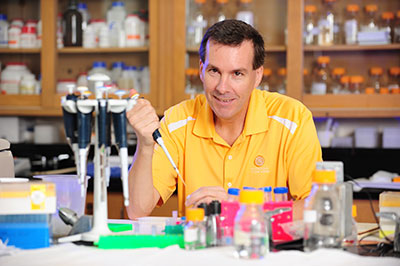 |
|
| Dr. Daryl Somers, research director in the Applied Genomics program. Photo courtesy of Vineland Research and Innovation Centre.
|
Buitenhuis agrees. “Some of the concerns over expense are related to the first-year experience where you may be spending more money because you’re experimenting to figure out what works best in your greenhouse.”
And making a comparison to a pesticide program is difficult. You have to factor in the labour costs of applying the chemicals, and the re-entry period in which you can’t access the crop, along with the costs of product rotation and the possibility of resistance. “It’s a very complicated equation,” says Brownbridge.
Growers don’t have to look far to find examples of successful biocontrol programs. “We’re lucky here in Canada to have so many growers who have persisted and use biocontrols successfully,” says Buitenhuis. “They show they are sustainable and that they work.”
Vineland’s work is aimed at providing growers of ornamental and vegetable crops with tools and knowledge to ensure that biological control can be carried out successfully in a range of production systems.
MICROBIAL INOCULANTS
Prevention programs are equally important with greenhouse vegetable crops. Microbial inoculants are increasingly being applied to prevent soil-borne diseases. Vineland researchers are now studying the best way to utilize microbial inoculants (or derivatives) to prevent root diseases in hydroponic tomato crops and how this might affect overall plant health and its susceptibility to foliar pests.
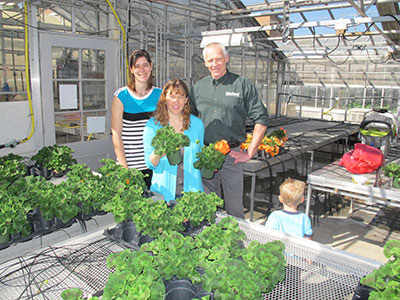 |
|
| Drs. Anissa Poleatewich, Michael Brownbridge and Rose Buitenhuis in the greenhouse where Poleatowich and her team are evaluating biocontrol of Pythium in geranium.
|
Several commercial products are available and others are being considered for registration.
The application of these microbes often activates the plant’s defence pathways. If you’re applying something to the roots for control of diseases, is it also going to have an impact on the plant’s resistance to foliar diseases? And if the plant is much healthier, will it be more attractive to pests, or will there be other effects on the pest’s biology and ability to thrive on the host plant? These are just a few of the questions that need to be addressed.
Researchers need to know all this, because it has implications for every crop strategy that comes afterwards.
The scientific literature suggests there will be effects on other parts of the plant, and, in a production system, it is important to understand these effects so that control strategies can be adapted accordingly. The research will provide the answers.
BIOCONTROL COMPATIBILITY
Vineland researchers are also addressing the compatibility of various biocontrols. Quite often, several predators are used concurrently, along with periodic pesticide applications where necessary. Information on compatibility is important and integrated use practices must be developed to ensure the products are cost-effectively and reliably used together.
To date, the researchers have evaluated strategies for control of thrips on mums and for whiteflies on poinsettias.
Vineland is also increasing its extension work to promote biocontrol research and strategies. Planned this year are a series of educational initiatives to present the latest information on thrips control. Included will be an interactive online tool and a number of workshops.
“Doing a little more extension work puts us in even closer contact with growers to get their feedback,” says Buitenhuis. “From the get go, we design our experiments based on the priorities set by the industry.”
Funding for this research has been provided by the Ontario Greenhouse Vegetable Growers/Agricultural Adaptation Council; Flowers Canada Ontario/Ontario Farm Innovation Program; Koppert Canada; Novozymes Biologicals; BioWorks and Crop Defenders.
AUTOMATION FOR IMPROVED EFFICIENCY
Improved efficiency will play an increasingly greater role with ensuring the competitiveness of Canadian greenhouse growers.
Labour costs are rising, and labour shortages remain a challenge, especially during peak seasons.
“Competitiveness is a big issue in Canadian horticulture,” says John Van De Vegte, project manager of Robotics and Automation. “This is a global industry.”
The focus of all projects undertaken is to reduce production costs and increase quality.
“Our labour costs can be challenging, and often labour availability is as much of a challenge as is the cost, especially with the peaks and valleys of production requirements.”
Robotics and automation can help growers better manage their labour requirements year-round, and with improved product quality as the bonus.
“Automation helps to level out labour demands, and quality standards are consistent with robotics.”
It also frees up staff to work on more crop monitoring and maintenance.
AUTO SECTOR BOOST
Ontario is a robotics leader, thanks to its highly automated auto sector. Many of those technologies are transferable to horticulture, though the grippers must be far more sensitive.
“Picking up identical car parts is one thing, but what about picking up tomatoes? Each one is different. There’s definitely much more fragility in the products being handled (in horticulture.)”
His program, only 30 months old, certainly hit the ground running. The following projects are undergoing final fine-tuning.
- Flexible Robotic Planting System: This automated system employs vision-guided robotics to conduct a variety of planting operations for the ornamental greenhouse sector.
It handles plug transplants for a variety of seedling sizes, plant cuttings and plant tulip bulbs by taking advantage of the modular design, quick-change tooling and flexible robot programming.
- Robotic Packaging System: This system conducts the packaging process for 4” and 6” potted plants by integrating a four-axis robot with other custom-designed mechanisms.
That packaging system was a hit at last fall’s Canadian Greenhouse Conference. Each demonstration attracted a large crowd of growers with no shortage of questions.
“We had a lot of positive feedback from growers. They realize this technology is coming. They also appreciated that you don’t have to be a rocket scientist or brain surgeon to operate it. It’s so user friendly.” (The most common question? “How much does it cost?”)
- Mushroom Harvest System: This project employs a vision-guided robotics to automatically graze harvest mushrooms from a bed.
With the development phase of these projects coming to a close, the next step is their commercialization to make them available to growers.
Van De Vegte is also studying opportunities in the greenhouse vegetable sector. There are opportunities to further automate packaging operations. “We have a good sense of what we need to do,” he says. Work on a financial analysis of such systems is underway to ensure a reasonable payback period.
“It’s looking positive at this point. We’re now looking for some partners to work with.”
Much like his work on ornamental automation systems, he will be working closely with greenhouse vegetable growers and shippers. “You won’t be successful if you don’t have the right people involved,” he notes. “They’ll tell us exactly what they want and what they need.”
He works closely with Vineland engineering colleague Dr. Bernard Goyer, a post-harvest specialist.
“Another advantage we have at Vineland is that we can call on other experts here to share their expertise with these projects.”
The program has been partially funded by the Federal Development Agency of Southern Ontario. The balance of program funding has come through the generous support and contributions by program partners. Among them are AEMK Systems; CMP Automation; Harvest Robotics; John G. Wilson Machine; Niagara College; Pioneer Flower Farms; Sunrise Greenhouses; and Westbrook Floral.
“There are no shortages of challenges that need to be addressed,” says Van De Vegte, “we just have to develop the right solutions.”
COMMERCIAL PARTNER
WELCOMES A CHALLENGE
If they had such designated spaces, Vineland's visitors' parking spots would rarely be empty.
Commercial partners are regular visitors, keenly involved with many projects.
CMP Automation is one such example.
The Ayr, Ontario, company has been a leading robotics integrating company for many years.
CMP Automation general manager Rob Shwery has been involved with robotics integration for 30 years. He has extensive experience with automotive, electronics, medical, consumer and pharmaceutical applications.
He can now add "horticulture" to the list.
CMP Automation has been working the past few years with the John Van de Vegte and the Vineland automation/robotics program, and with great success.
When first approached to work on a robotics system for transplanting tulip bulb, Shwery said he was "immediately intrigued. It was really outside what I had previously worked on."
ROBOTIC INTEGRATION
But he was confident, given the company's experience and expertise, "that we could offer some innovative solutions on how to integrate robotics."
Ontario is a recognized world leader in robotics, especially with work in the automotive sector. But horticulture is a new field, says Shwery. "We're at the ground floor in horticulture with robotics."
However, he notes there's been a lot more work in Europe with companies working to integrate robotics into horticulture.
"We can provide a solution to do just about anything within reason," he explains, "but the challenge is to do it economically. It has to be offered at a price where a grower will say it's affordable to use in their greenhouse."
CMP Automation, along with several other commercial partners, has helped Vineland develop its planting and packaging prototypes, which are now being fine-tuned for commercialization.
The systems were engineered to be especially user-friendly, he said. No special tools are required to change over to different products or sizes. Also, operator training is very straightforward and simple.
The systems will help growers remain competitive. "It's not just a question of speed, but it's the accuracy, quality and consistency of the process," Shwery explains. Robots can repeat the same process exactly the same way every time, whereas with manual labour, there can be some fluctuation.
There are initial capital costs, "but the robotics will offset manual labour costs in a relatively short period of time."
One key challenge is ensuring the gripping systems are gentle enough to handle young plants. "If the robot is picking up a seedling, or must get in between some leaves to grab a stem, it has to be a gentle process."
NEW GRIPPER TECHNOLOGY
And with tulip bulbs, there is variability in the shape and size among varieties of bulbs. Vacuum cups are used with bulbs. However, there is exciting new gripper technology being developed that Shwery is closely watching.
"We can easily transfer this emerging technology into what we need here."
CMP was started in 1988 by brothers Dan and Henry Weinhardt. Dan is the New Business Development Manager, while Henry is the Director of Sales and Marketing.
They began by manufacturing metal products before branching out to produce tube benders. Other companies soon began approaching them to manufacture other systems, and CMP then evolved into a leading custom machinery company. Most recently, they have been working on material handling systems for the oil and gas industry.
Shwery joined the company in 2000 as General Manager.
CMP has installations throughout Canada, the U.S., Mexico, the U.K., Slovakia and Australia, to name only a few countries.
"Our specialty is in turnkey systems," he says. "Our customers are looking for a complete solution. We design, build, install and train the customer on the equipment we manufacture."
Shwery sees great potential for increased automation in horticulture.
"It's an industry well-known for innovation."
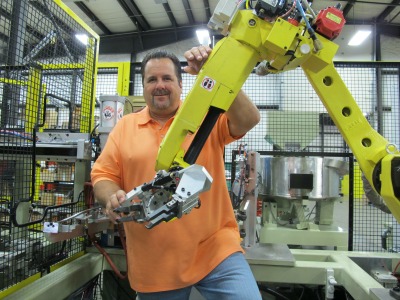 |
| Rob Shwery of CMP. |
Print this page